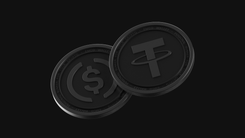Aave Token: What It Is, Overview, Price

June 2025 confirms it once again: the cryptocurrency market continues to attract both seasoned traders and newcomers hoping to grow their capital. The chance to earn multiple times the invested amount is still real — but no longer as easy as it used to be.
Investors have long noticed that the top 10 cryptocurrencies by market cap (such as Bitcoin, Ethereum, Solana, and others) have become a kind of “blue chips”. Yes, they’re reliable, but sharp price swings are the exception rather than the rule. Quick, large profits here often fail to materialize.
That’s why more and more attention is shifting to so-called second- and third-tier “altcoins” — young projects with relatively low market caps but strong ideas and the potential to grow 5–10 times over (and sometimes more). This is where the real “hidden gems” of the market lie — the key is to spot them before everyone else does.
Today, one of the most efficient ways to profit from crypto is to hunt for undervalued projects with a solid team, strong technology, and real-world use cases. Sectors related to AI, GameFi, decentralized social networks, and Web3 infrastructure are especially popular now.
If you don’t want to just watch crypto growth from the sidelines but actually earn from it — it’s time to dig deeper and look beyond the top 10. As of June 2025, the market offers plenty of opportunities — the only question is who’s ready to seize them.
Contents:
- What to Look for When Choosing a Promising Token in 2025
- What Is Aave and the AAVE Token
- History of the Aave Project
- How the Aave Platform Works
- The Role of the AAVE Token in the Aave Ecosystem
- How to Obtain and Use the AAVE Token
- Factors Influencing the Price of the AAVE Token
- Advantages and Disadvantages of the AAVE Token
- Prospects for the Development of Aave and the AAVE Token
- Is It Worth Investing in the AAVE Token?
- FAQ
What to Look for When Choosing a Promising Token in 2025
In an oversaturated crypto market, spotting truly worthwhile projects is getting harder. Still, there are a few key signs that help identify a token with strong growth potential.
Innovative technology
Among hundreds of similar projects, those offering genuinely fresh ideas stand out the most. The more unique the technical solution, the higher the investor interest.
Active community
Without a lively, loyal community, even the best-planned project risks fading into obscurity. People willing to spread the word, participate in votes, and defend the project on social media are what drive popularity.
Transparent roadmap
Teams that openly share their plans — from upcoming releases to strategic goals for the next 2–3 years — earn trust. Investors value having a clear sense of where a project is headed.
Real-world use cases
Projects that solve real problems — whether in finance, gaming, logistics, or data — have a clear advantage over those that exist purely for the sake of blockchain.
Partnerships and funding from major players
Interest from venture capital funds or well-known companies is a strong signal. Such collaborations bring not only money but also valuable credibility.
Why AAVE Deserves Attention: A Look at DeFi in 2025
Most promising tokens today offer investors not just the chance to profit from price growth but also the opportunity to be part of cutting-edge digital technologies. More and more, investors prefer tokens tied to real innovation and useful infrastructure rather than coins created purely for speculation.
Since the late 2010s, the DeFi sector — decentralized finance — has gained popularity. This field has become one of the main growth drivers of the crypto market, providing an alternative to traditional banks and financial intermediaries.
AAVE cryptocurrency is one of the flagships of this sector. It’s backed by powerful technology that allows users to lend and borrow funds without centralized entities. Everything is done through smart contracts — transparently, securely, and available 24/7.
Today, we’ll take a closer look at what makes AAVE special, how its platform works, and why this token remains one of the most respected names in the DeFi world.
If you want to start earning from this token and other cryptocurrencies today, the EMCD platform can help you do it.
What Is Aave and the AAVE Token
As of 2025, Aave is one of the most popular decentralized lending protocols in the cryptocurrency market. Built on the Ethereum network, the Aave protocol ensures the reliable operation of its smart contracts. Users have the following main features:
- Deposits in cryptocurrency into liquidity pools
- Loans secured by crypto assets
- Instant unsecured loans (Flash cryptocurrency loans) — require repayment within the single transaction (within the single block)
- Participation in project development — all AAVE token holders have voting rights to approve changes to the project
- Staking — in addition to deposits, clients can temporarily lock their assets to help secure the network and earn rewards for doing so. Unlike deposits, which fund loans and other investments, staked coins mainly help to ensure protocol security
- Support for multiple blockchains — the Multi crypto chains feature allows users to work not only on the main Ethereum-based network but also across 11 other blockchains. Supported networks include Polygon, Arbitrum, Avalanche, and Optimism. Due to multi-chain support, clients can use Aave’s core features in networks with lower fees and faster transactions
The Aave protocol is managed by the AAVE token. It’s common practice to refer to “Aave” when discussing the protocol and its platforms, and “AAVE” when referring specifically to the governance token. Token holders can:
- Participate in project governance by voting on developer proposals
- Earn rewards by staking the token in the Safety Module
- Sell the token when its price rises (like any other cryptocurrency)
- Use the token to repay loans taken on the platform
- Invest AAVE in liquidity pools
As of 2025, the project has achieved the following milestones:
- Total deposits valued at around 30 billion USD
- Token market capitalization of about 4 billion USD
- Daily trading volume of over 550 million USD
History of the Aave Project
The project was founded in 2017 by Finnish lawyer and financier Stani Kulechov and was originally named ETHLend. In November of that year, the platform held an ICO for LEND tokens, raising over 16 million USD. In 2018, the project was rebranded as Aave, which means “ghost” in Finnish. The name symbolizes the protocol’s transparency and the fact that intermediaries in this system remain invisible.
In 2020, the platform launched its native AAVE token, and all LEND token holders were given the option to swap their tokens at a 100-to-1 rate. That same year, the Aave platform went live, allowing users to lend and borrow funds as well as to stake their tokens. Additional features were later added, including Flash Loans and cross-chain support for various cryptocurrencies.
As of 2025, the platform has secured its position as a recognized leader in the DeFi sector, with a market share exceeding 14%. The average monthly number of active users is now around 80,000.
How the Aave Platform Works
The platform automates lending and investing (deposits and staking) through smart contracts based on the Ethereum network and 11 other blockchains.
The lending process works as follows:
- Investors deposit funds into liquidity pools. When choosing a pool, users can access advanced metrics to evaluate risks and potential returns.
- Borrowers take loans from these pools, using their crypto assets as collateral, and can choose from different available pools.
- For using the borrowed funds, borrowers pay interest, which is distributed among the investors in the pool and the platform itself.
- If a borrower fails to make required payments on time or if the estimated value of the collateral drops below a safe level, the collateral is automatically liquidated (sold), and the proceeds are distributed to the investors. The safe price level is set individually for each asset.
How AAVE Works: Smart Loans Without Banks or Intermediaries
At the core of the AAVE platform is a well-designed and transparent lending mechanism. One of the key metrics here is LTV (Loan To Value), which is the ratio of the loan amount to the value of the collateral asset. This parameter determines how much can be borrowed against a specific cryptocurrency.
It is also important to consider the Liquidation Threshold. This is the price at which the collateral is automatically sold by the system to cover the debt. In addition, forced liquidation imposes an extra penalty on the user — the so-called Liquidation Penalty.
Thanks to clearly defined rules, transparency, and automation of all processes, AAVE enjoys wide popularity. For investors, it offers a reliable and profitable way to allocate assets. For borrowers, it provides convenient access to liquidity without needing to sell their cryptocurrency.
There are various reasons why users take loans on AAVE. Sometimes urgent fiat funds are needed but selling accumulated crypto is undesirable — in this case, the collateral is returned to the borrower after full repayment. Another strategy is playing the market down: by borrowing a certain coin, selling it immediately, then buying it back when the price falls, profit can be made on the difference. Conversely, a bullish strategy allows taking a loan against a growing asset and reinvesting the funds into the same coin to increase potential profit.
AAVE makes all these operations accessible, automated, and secure, acting not just as a platform but as a full alternative to traditional financial services.
The Role of the AAVE Token in the Aave Ecosystem
The AAVE token plays a key role in governing the protocol and platform. AAVE holders can vote on changes to platform rules and parameters — for example, adding new assets, adjusting risk levels, or implementing technological innovations. The token can also be staked by placing it in the Safety Module, which protects the protocol from liquidity shortages. Participants receive rewards for this.
Finally, the token can be used to repay loans or make investments. In this way, the AAVE cryptocurrency token serves governance, incentive, and protection functions within the Aave ecosystem. Token holders can use it like any other cryptocurrency, either passively investing it to support the project’s infrastructure or actively participating in its development through voting.
How to Obtain and Use the AAVE Token
The token can be purchased on popular cryptocurrency exchanges such as Binance, Coinbase, Bybit, Bidget, or Kraken. It is also available on P2P platforms, including EMCD. After purchase, it can be used to participate in voting, staked in the Safety Module to earn rewards, or simply held as an investment. Additionally, AAVE can be used within the protocol to pay fees, secure loans, and invest in liquidity pools.
To interact with the Aave platform in any way, including buying and selling the token, you need a crypto wallet. The AAVE token is supported by many popular crypto wallets, including:
- EMCD wallet — a popular custodial multi-currency wallet that is part of the EMCD ecosystem with a P2P platform, the Coinhold investment service, and a mining pool
- MetaMask — one of the most convenient wallets for working with DeFi protocols and the Ethereum network
- Trust Wallet — suitable for mobile platforms and supports many cryptocurrency networks and blockchains
- Ledger — a hardware wallet providing a high level of security for token storage
- Coinbase Wallet — offers easy integration with decentralized applications
AAVE cryptocurrency can also be safely bought and sold through Rabby and Argent wallets, which are designed for Web3 and DeFi interactions.
Factors Influencing the Price of the AAVE Token
As of June 2025, the price of this cryptocurrency is approximately $270 per 1 AAVE. Since March of this year, a steady increase in the token’s price has been observed. Between May 2022 and July 2024, the token price remained historically low, fluctuating around the $100 mark per token. The highest recorded value for this coin was in May 2021, reaching $528.
Historically, the price of this token has been influenced by several key factors:
- General trends in the cryptocurrency market and the DeFi sector — tokens tend to rise and fall alongside BTC and ETH, and also grow as investor interest and activity from large borrowers in decentralized finance increases
- TVL (Total Value Locked) — the more users stake tokens to support the network’s stability, the greater the trust investors place in the token
- Competition with other DeFi projects — the token’s position depends on how its platform compares to competitors like Compound, MakerDAO, and others
- News environment — exchange conditions and regulatory news related to cryptocurrencies and DeFi in various countries strongly impact the token’s price
- Project updates — new platform features and protocol improvements can either boost interest or deter some users
Advantages and Disadvantages of the AAVE Token
The main advantages of this coin:
- Association with one of the largest DeFi platforms
- Real-world use cases for the underlying technologies
- Proven longevity — the token has existed since 2020, while the platform was founded in 2017
- High liquidity
- Listed on most major cryptocurrency exchanges
- Support by many popular wallets
- Opportunity to participate in the governance and development of the Aave platform
- Access to investment opportunities such as lending and staking
Disadvantages of the AAVE token include:
- Strong price dependence on the overall cryptocurrency market and DeFi sector conditions
- Intense competition within the DeFi ecosystem
- Regulatory risks in the US, EU, and other jurisdictions
- High volatility, a common issue for DeFi-related tokens
- Relatively limited integration with the platform — AAVE serves as one of several supported payment methods on the platform, which, while convenient, constrains its growth potential
- Presence of the parallel GHO stablecoin from the same platform, which divides investor attention and may further limit AAVE’s popularity
Prospects for the Development of Aave and the AAVE Token
The Aave platform has already achieved the status of the largest project in the DeFi sector. To maintain its leadership position, the team can focus on several key areas:
- Adding new features
- Developing its own tokens, including the AAVE token and the GHO stablecoin
- Expanding support for third-party blockchains
- Growing the liquidity market through Aave Arc, which complies with AML (Anti-Money Laundering) regulations, making it attractive to institutional investors
- Diversification — for example, the Aave Labs team is actively working on the Lens Protocol, a Web3 social network. Further integration of such side projects into the Aave ecosystem could significantly broaden its capabilities and attract thousands of new users
Developers at Aave Labs have already shown their ability to innovate and implement useful features, and the community has consistently supported these initiatives. Therefore, the near-term outlook suggests a strengthening of the platform’s leadership in the decentralized finance sector.
In 2025, various expert groups forecast the AAVE token price to rise to between $270 and $526 per coin. The lower price threshold is expected to remain above $100.
Factors likely to drive token growth include:
- Implementation of new protocol features
- Successful development of the GHO stablecoin, provided it does not displace AAVE as the platform’s primary payment token
- Expansion of the DeFi sector and cryptocurrency market
However, growth may be limited by the following risks:
- A downturn in the cryptocurrency market and/or the decentralized finance sector
- Competition from other platforms offering similar functionality
- Regulatory restrictions
Is It Worth Investing in the AAVE Token?
AAVE is a promising asset both for DeFi enthusiasts and for regular investors willing to wait for price growth over the coming months or even years. The token is linked to the largest platform in the DeFi sector, backed by a competent development team and a large community. Continuous platform updates and new features designed for both individual borrowers and institutional investors further increase interest in the token.
However, the token’s novelty and the innovations behind it have long since matured, making a rapid multi-fold price surge unlikely in the near future. Competition within the DeFi sector is increasing, and new platforms may impact the token’s popularity. Regulatory risks also remain significant, as the concept of decentralized finance naturally raises concerns among governments of major states with centralized economic control mechanisms. Another challenge for AAVE is its strong dependence on the overall market condition, which in 2025 has experienced both sharp rises and significant declines.
Therefore, our recommendation is to invest in this token with a diversified portfolio, stay informed about developments in the crypto world, and never invest more than you are prepared to potentially lose.
FAQ
What is the AAVE token and what is it used for?
AAVE is a token used within the Aave decentralized finance platform. The platform allows people to borrow and lend cryptocurrency without involving banks. The system operates through smart contracts on the Ethereum blockchain and other networks, including Polygon and Arbitrum.
The AAVE token serves several important functions:
- Voting on the project’s development
- Earning rewards by locking AAVE in the security module (staking)
- Usage within the protocol for loan repayment and liquidity provision
AAVE is not just a coin but a key to participating in one of the most popular DeFi projects globally. Like any cryptocurrency, the token can be freely bought, sold, and exchanged, allowing users to profit from price fluctuations.
How to earn with the AAVE token?
Token holders have several ways to earn:
- Selling when the price rises — like with any other cryptocurrency
- Staking — locking tokens to support the network
- Investing in loans (liquidity pools)
- Using the token as collateral to open short positions — this way, you can profit even if the token’s price falls
Where can you safely buy AAVE tokens?
AAVE tokens can be safely purchased on well-known cryptocurrency exchanges such as Binance, Coinbase, Bybit, Bidget, or Kraken. These platforms are regulated, offer high security, and are user-friendly for beginners.
AAVE is also available on P2P platforms like EMCD, where users can buy tokens directly from each other.
To use or store the token, you need a crypto wallet. Reliable wallets include EMCD Wallet, MetaMask, Trust Wallet, Coinbase Wallet, Ledger, Rabby, and Argent.
What are the risks of investing in AAVE?
Despite the many advantages of this token, any investment comes with risks. The main ones are:
- Price volatility — like any cryptocurrency, sharp increases can be followed by equally sharp drops
- Competition — in the DeFi sector, any new platform has a chance to succeed, so being a market leader doesn’t guarantee Aave’s future dominance
- Regulation — governments tend to distrust decentralized finance, which can limit the development of related projects
Remember, investing in any cryptocurrency also involves security risks. Always use a reliable wallet — for example, EMCD Wallet. Also, follow basic safety rules: never share information that could allow someone to hack your wallet, and avoid disclosing the size or source of your income to strangers.
What is the current price of the AAVE token and what influences it?
As of June 2025, one AAVE token is worth around $270. The price depends on several factors, including:
- Supply and demand for the token
- Trends in the crypto and DeFi markets
- Competition within the sector
- News and regulatory developments
- Progress and updates to the project
- TVL — a metric indicating user trust in the platform
How is Aave different from other DeFi projects?
Aave stands out from other DeFi projects thanks to its support for flash loans — instant, unsecured loans — its multi-chain protocol structure, and flexible configuration options. Another key feature is its native AAVE token, which is integrated into the platform’s economy and allows users to participate in shaping the project’s development strategy.




